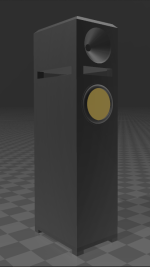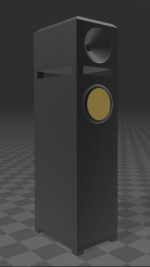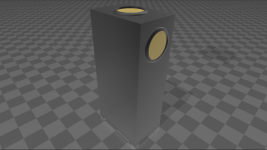I'm currently thinking about modifying my speaker cabinets and thought of a design that could have a wider distribution angle.
So I started with this one, which is a push-push (bipole), with three speakers, each pointing in a different direction (front, top, rear).
The back is the same as the front, except it has the terminal to place the wires.
A box with the tweeter will be on top of the bass box, with a small space that will appear to be an omnidirectional design.
So I started with this one, which is a push-push (bipole), with three speakers, each pointing in a different direction (front, top, rear).
The back is the same as the front, except it has the terminal to place the wires.
A box with the tweeter will be on top of the bass box, with a small space that will appear to be an omnidirectional design.
Attachments
Last edited:
When some people talk about a push-push speaker arrangement, the feature they are interested in is the secondary action of vibration cancellation. For this reason, expect to have to be specific when discussing it.
There are two separate reasons on the table. The solutions to both are different. How can I answer you if you oversimplify the question?
My question is: Will the one on top work as an omnidirectional design?
Since the tweeter box is on top of it with a small space for the sound to exit to all four sides.
Since the tweeter box is on top of it with a small space for the sound to exit to all four sides.
Ignoring “push-pull” or “push-push” by assuming 2 drivers in the 2nd model both operating in-phase:
the up-firing woofer will have some pressure loss as freq.s scale higher than about 700-1kHz (depending on the diameter of the driver), and more so as the driver ”beams” at about an octave above this. This is also dependent on the amount of reflections from the waveguide “box” above it.
There will also be a bit of delay from the physical off-set.
If it’s done well you can sometimes use this extreme off-axis approach for bafflestep compensation (without a passive or active filter) but it takes a lot of trial and error and typically with raised out-door measurements. Note: when I’ve used this technique it was with the bafflestep compensation woofer on the “far” side of the side panel of the speaker.
the up-firing woofer will have some pressure loss as freq.s scale higher than about 700-1kHz (depending on the diameter of the driver), and more so as the driver ”beams” at about an octave above this. This is also dependent on the amount of reflections from the waveguide “box” above it.
There will also be a bit of delay from the physical off-set.
If it’s done well you can sometimes use this extreme off-axis approach for bafflestep compensation (without a passive or active filter) but it takes a lot of trial and error and typically with raised out-door measurements. Note: when I’ve used this technique it was with the bafflestep compensation woofer on the “far” side of the side panel of the speaker.
Sort of depending on the freq., but done like that is not a good idea unless it has its own low-pass filter.My question is: Will the one on top work as an omnidirectional design?
Since the tweeter box is on top of it with a small space for the sound to exit to all four sides.
Better to do it without the reflector.
- Home
- Loudspeakers
- Multi-Way
- Push-push triple


